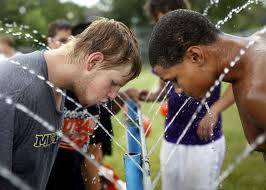High School Football & Dangers of Dehydration

It’s official! Football season is here. Collegiate practices have started, NFL pre-season is underway and high school football players and coaches are starting to pull out the equipment and plans for fall workouts. This time of year, I find myself talking to everyone about the importance of hydration during football practice. Throughout training – including before, during and after – both players and coaches must focus on maintaining adequate hydration levels. Drinking plenty of fluids and staying well-hydrated benefits on field performance while reducing the risk of heat stress or illness.
What are the signs and symptoms of dehydration that coaches should be aware of?
The first sign of dehydration is thirst and general discomfort. Then as dehydration becomes more severe, flushed skin, general fatigue and possibly the onset of muscle cramping can occur. As players continue to dehydrate, they can become dizzy, have a headache, vomit, and/or have chills. Similar to other things, there’s a progressive physical decline as you become more and more dehydrated.
How much is enough?
Athletes should drink at least 3.7 liters daily, which is the minimum recommended by the Institute of Medicine (IOM) and up to 10 liters to match losses. Unless weight gain is desired, the fluids used should be low in sugar, including water, low sugar flavored water, juices, low fat milk, and an occasional low sugar ice tea or soft drink.
Before practice, athletes need about 16 to 24 ounces (2 to 3 cups) of water, two to three hours before training and games. While on the sidelines and in the locker room, players should drink at least 8 to 10 ounces every 15 to 20 minutes, or more if they sweat heavily. After training, replenish with at least 64 ounces (8 cups) fluid, and even up to 1 ½ times that amount (96 ounces) to be completely rehydrated. Beverages that are cooler than room temperature are absorbed best, since they move throughout the bloodstream to the muscles faster. Fluids that taste good are also more likely to be consumed, so find your favorite and drink up!
After practice, replacing fluids at a rate of 1 to 1 ½ times the amount lost, or about 16 to 24 ounces of fluid for every pound lost at practice, is critical to remaining hydrated. During training, weighing before and after practices is a good way to estimate fluid losses: weigh before practice and after practice and subtract them and multiply the weight loss by 16 oz., next practice this much fluid should be added. For example, if you lost 2 lbs., add 32 oz. of fluids.
One of the simplest ways to measure hydration levels is by urine color. Urine that is slightly darker than lemon juice is good. If it’s as dark as or darker than apple juice, an athlete is dehydrated. If it’s completely clear, the athlete is hyper-hydrated.
SPORTS DRINK OR WATER DURING PRACTICES AND GAMES?
Both will help you stay hydrated. A sports drink also has sodium, which helps the water in your drink stay in your blood. Notice your sweat tastes salty? That’s the sodium you are losing in water. Sports drinks also give you energy from carbohydrates. Stay hydrated, stay safe, stay in the game!
ABOUT MICHIGAN SPORTS & SPINE CENTER:
We’re innovative leaders utilizing cutting-edge technologies such as musculoskeletal ultrasounds, PRP, stem cell treatment, and other innovative procedures. Michigan Sports & Spine Center is committed to resolving your pain, not simply masking it. We treat the whole body, not just the injury, and perform preventative treatment so your injury doesn’t come back. Our studies prove that Michigan Sports & Spine Center has patient success rates much higher than the national average. We treat everyone from high-profile athletes to your neighbor next door. Our primary focus is getting our patients back into the game of life!
